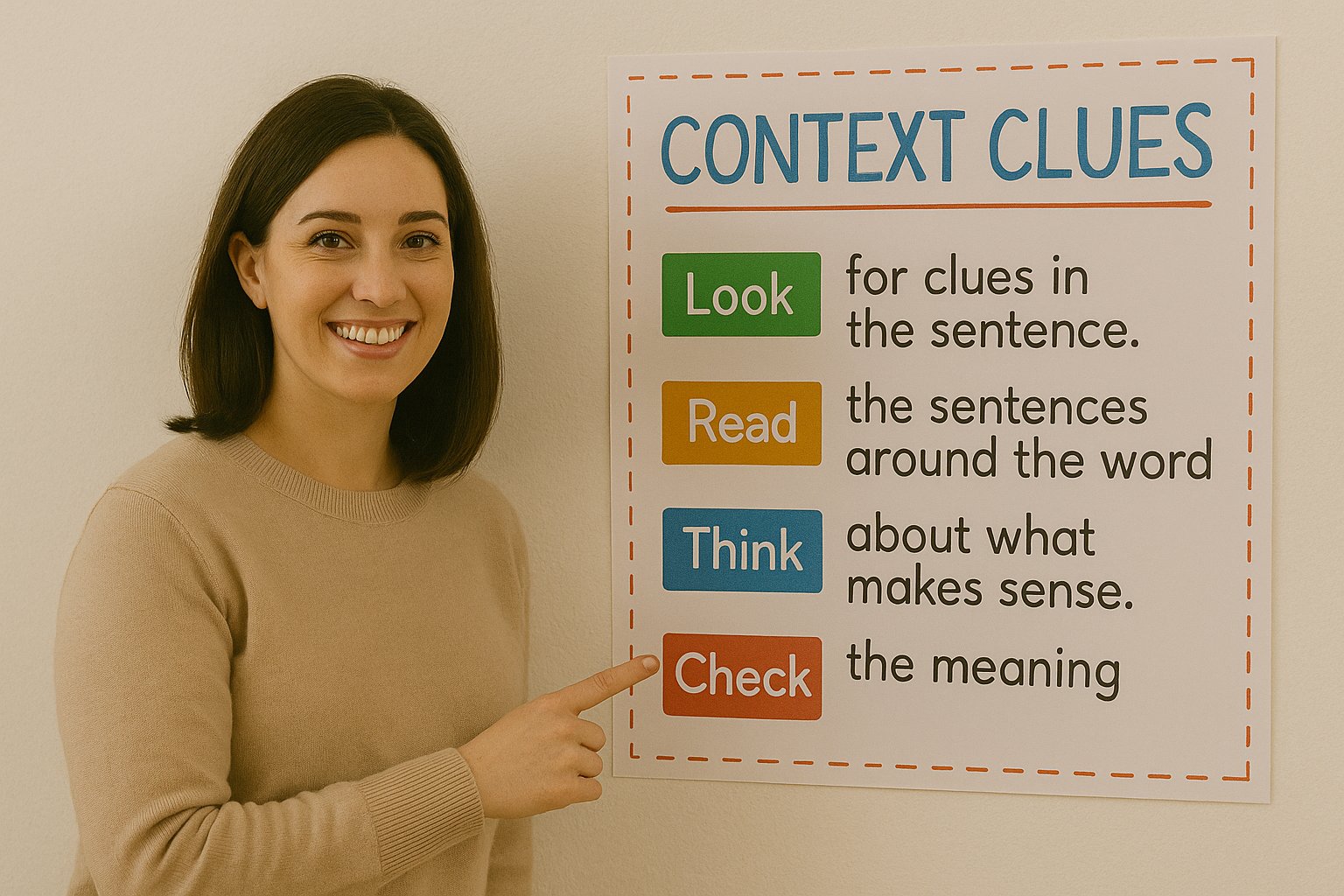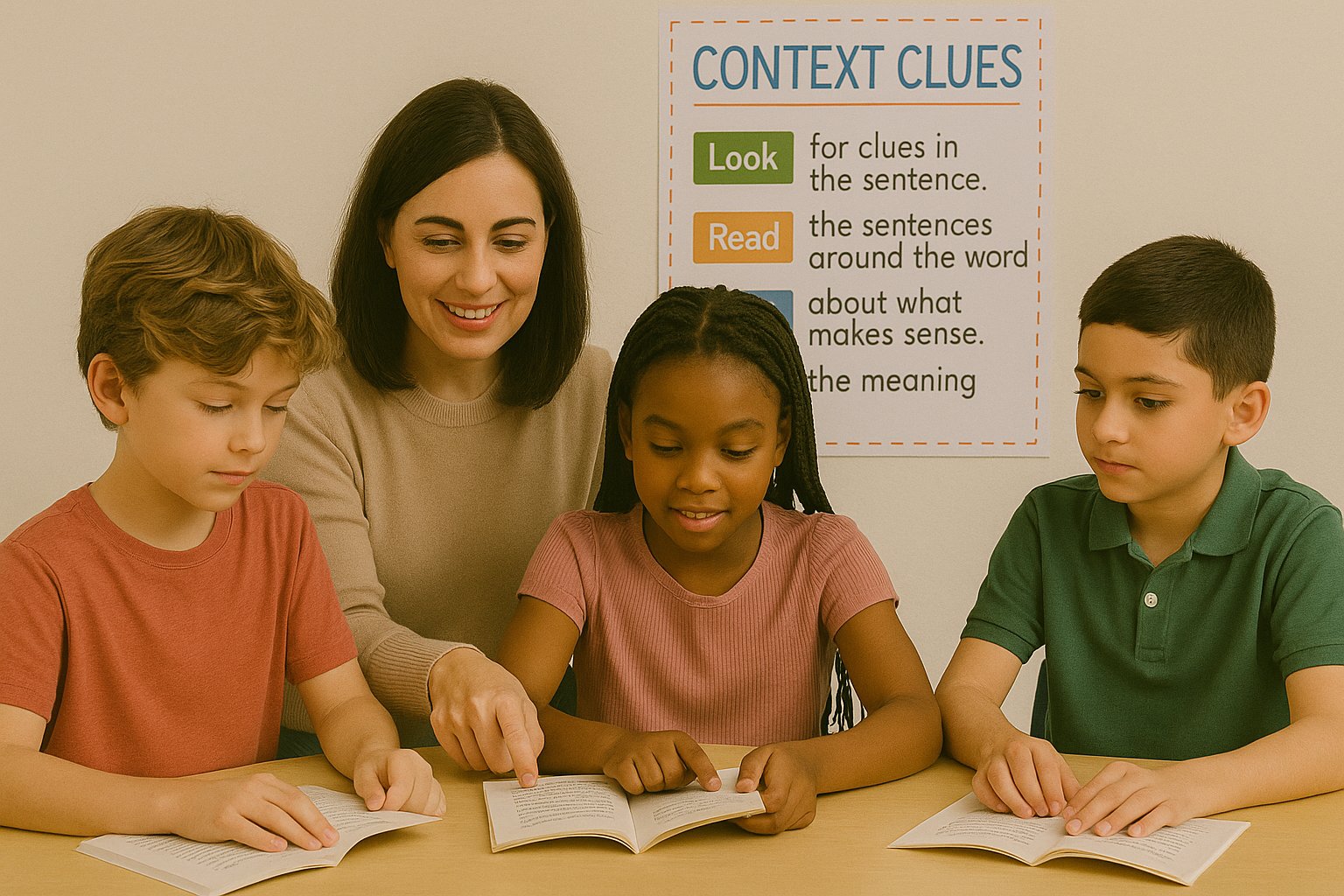
TL;DR (The Fast Answer)
Context clues are hints in the sentence or paragraph that help readers figure out the meaning of an unfamiliar word. Teach the big six: Definition, Synonym/Restatement, Antonym/Contrast, Example, Cause/Effect, and Inference. Give students signal words they can spot and 1–2 line routines they can do in seconds.
Why Teach Context Clues?
- Independence: Students don’t freeze on unfamiliar words—they investigate.
- Fluency & Comprehension: Less stopping = smoother reading and stronger understanding.
- Vocabulary Growth: Kids meet words in the wild and bring them into their speaking/writing.
Build the Anchor Chart (6 Types + Signal Words)
Post these six types with quick cues your learners can spot fast. Keep examples kid-friendly and reuse them across grades.
| Type | What It Does | Signal Words | Example |
|---|---|---|---|
| Definition | States the meaning directly. | is/are, means, refers to, is called | A habitat is the place where an animal lives. |
| Synonym / Restatement | Rephrases with similar words. | or, also called, in other words, —, (comma restate) | The arid desert, or very dry place, has little rain. |
| Antonym / Contrast | Shows the opposite for comparison. | however, but, unlike, instead, although | Unlike his timid sister, Max is bold. |
| Example | Lists items to clarify the word. | such as, including, for example, like | Conifers—such as pines and firs—keep needles all year. |
| Cause / Effect | Explains results to reveal meaning. | because, so, therefore, as a result | The deluge was heavy, so streets flooded. |
| Inference | Readers use clues + schema to infer. | (no fixed words—look for hints around) | She clutched her coat as the gale screamed—must mean strong wind. |
Mini-Lessons & Quick Routines
- Model one type with a 2–3 sentence passage. Highlight signal words.
- Try It Together: Students point to the clue type & underline the hint.
- Fast Check: Ask, “What does it mean? What clue proved it?”
- Spiral: Mix two types in one passage by week’s end.
Teacher tip: Keep a small stack of “mystery word” strips at your table for 60-second warmups.
Free Games & Activities (K–5)
- Comprehension Wednesday Runner — vocabulary in context while dodging/jumping; perfect for repeated practice (L.2.4–L.5.4).
- Comprehension Dance Battle — reveal a dance after each correct context-clues answer; kids beg for more.
- Learning Word Search Puzzles — embed target words; students use examples & synonyms to check meanings.
- Reading Art Showdown — read, answer, then draw the evidence—amazing for inference clues.
Need your own word lists or themes? ➕ Create a custom ABZ game in minutes.
Assessment & Progress Monitoring
Keep it short and skill-specific. Track which clue types students can spot and whether they can justify the meaning with evidence.
| Skill | Efficient Probe | Benchmark (Gr. 2–5) | Frequency | ABZ Tool/Game |
|---|---|---|---|---|
| Identify Clue Type | Label clues in 10 short items | 8+/10 correct | Monthly | Wednesday Runner |
| Explain Evidence | “What words proved it?” on 8 items | 6+/8 with specific text | Bi-weekly | Art Showdown |
| Apply to New Text | Decode 8 novel words in passages | 6+/8 correct definitions | Quarterly | Dance Battle |
Progress tip: Color-code the six types in your chart and use the same colors in worksheets, slides, and centers for instant transfer.
FAQs
Which context clue type should I teach first?
Start with Definition and Synonym/Restatement—they’re the most explicit—then move to Antonym, Example, Cause/Effect, and finish with Inference.
How do I help students cite the clue?
Use a two-part prompt: “What does it mean?” and “What words proved it?” Require highlighting or underlining the signal words.
Should I include morphology (prefixes/suffixes) on the chart?
Yes—briefly. Add a corner for “word parts help too” (re-, un-, -ful, -less) to support transfer across content areas.
Conclusion
Context clues turn roadblocks into ramps. Post the six types, rehearse the signal words, and keep practice quick and joyful. Pair the chart with ABZ mini-games and watch vocabulary—and confidence—climb.
Explore all ABZ Learning resources or build your own custom game in minutes.
